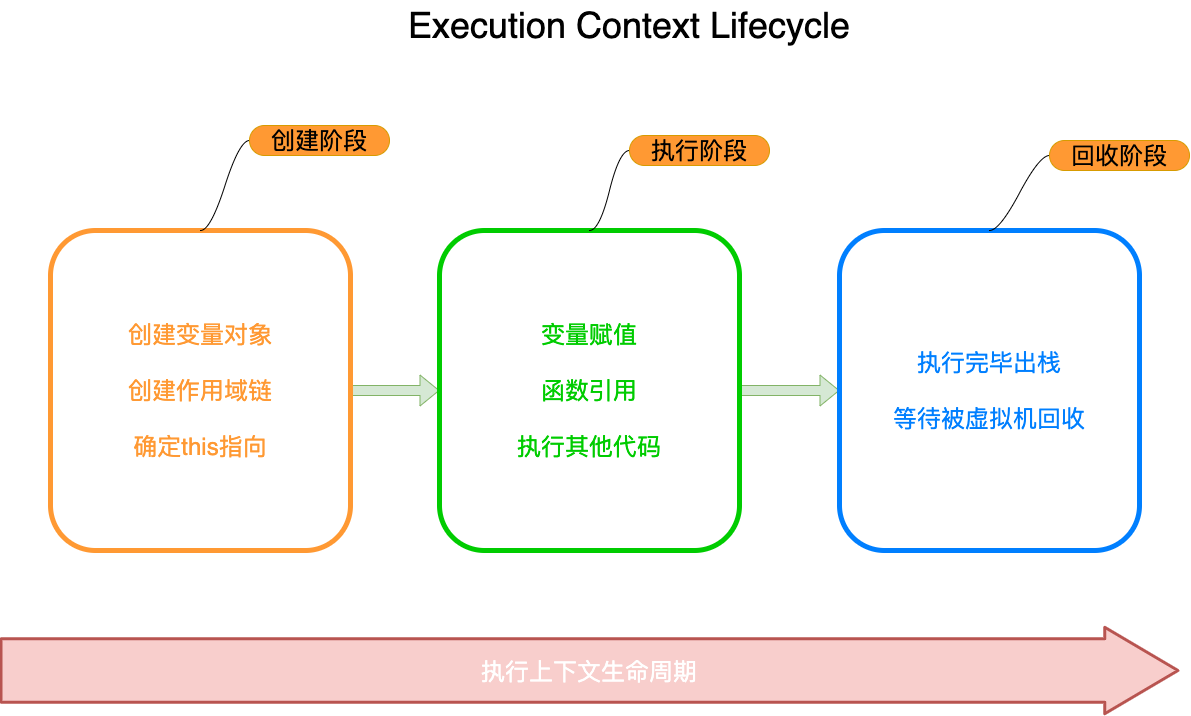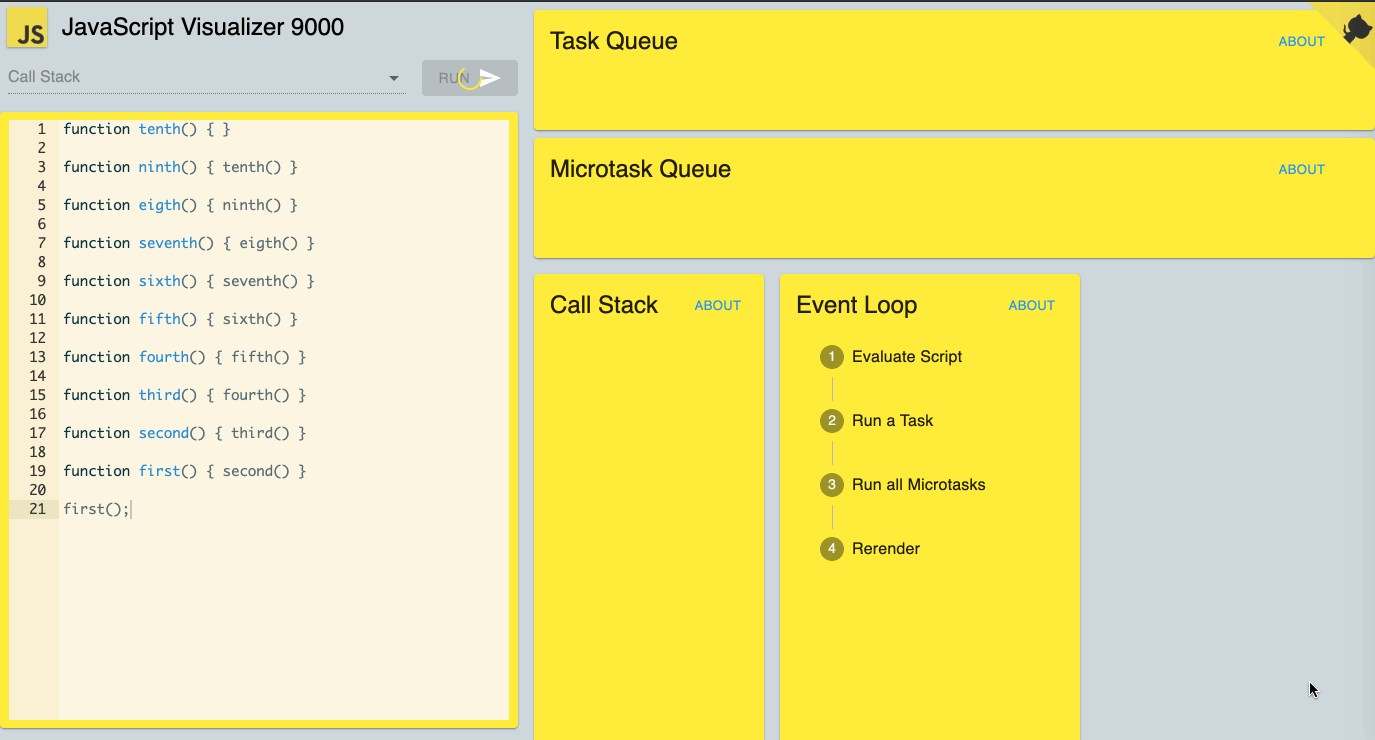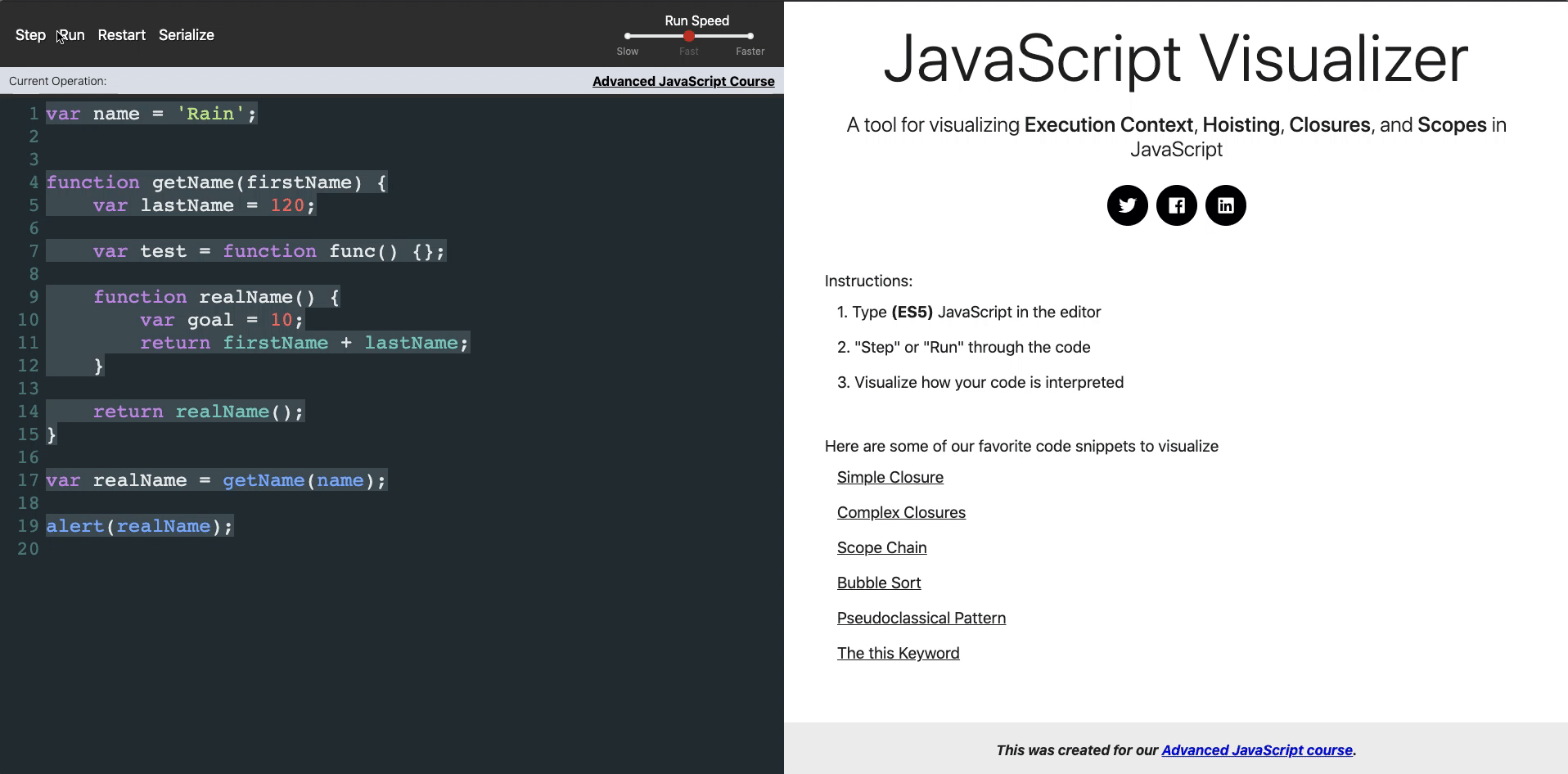执行上下文
此笔记有很多问题, 导致笔者有些混乱, 待笔者有空Review并重新整理
前言
想要了解 EC,需要先了解一下几个概念
- 作用域链
(Scope chain) - 执行上下文
(Execution Context or EC) - 执行环境栈
(Execution Context Stack or ECS) - 变量对象
(Variable object,VO) - 活动对象
(Activation object,AO)
作用域链 (Scope chain)
执行上下文 (Execution Context or EC)
执行上下文(EC)是评估和执行 JavaScript 代码的环境的抽象概念。每当 Javascript 代码在运行的时候,它都是在执行上下文中运行。
生命周期
执行上下文的生命周期包括三个阶段:创建阶段👉执行阶段👉回收阶段。
创建阶段
(ECMA 3 规范)
创建变量对象 (当前执行上下文)
建立作用域链
确定
this指向- 更多
this指向问题详见 Javascript this
(ECMA 5 规范)- 更多
确定
this指向- 更多
this指向问题详见 Javascript this
- 更多
创建词法环境
(Lexical Environment)A Lexical Environment is a specification type used to define the association of Identifiers to specific variables and functions based upon the lexical nesting structure of ECMAScript code. A Lexical Environment consists of an Environment Record and a possibly null reference to an outer Lexical Environment. Usually a Lexical Environment is associated with some specific syntactic structure of ECMAScript code such as a FunctionDeclaration, a WithStatement, or a Catch clause of a TryStatement and a new Lexical Environment is created each time such code is evaluated.
词法环境是一种规范类型,用于根据
ECMAScript代码的词法嵌套结构来定义标识符与特定变量和函数的关联。 词法环境由环境记录和对外部词法环境的可能为空的引用组成。 通常,词法环境与ECMAScript代码的某些特定语法结构(如FunctionDeclaration,WithStatement或TryStatement的Catch子句)相关联,并且每次评估此类代码时都会创建一个新的词法环境。创建变量环境
(Variable Environment)Identifies the Lexical Environment whose environment record holds bindings created by VariableStatements and FunctionDeclarations within this execution context.
标识词法环境,该词法环境的环境记录包含此执行上下文中
VariableStatements和FunctionDeclarations创建的绑定。
执行阶段
- 变量赋值
- 函数引用
- 执行其他代码
回收阶段
执行完毕出栈,等待被虚拟机回收

执行上下文类型
JavaScript 中有三种执行上下文类型。
全局执行上下文
(global)默认任何不在函数内部的代码都在全局上下文中。它会执行两件事:创建一个全局的
window对象(浏览器的情况下),并且设置this的值等于这个全局对象。一个程序中只会有一个全局执行上下文。函数执行上下文
(function)每当一个函数被调用时, 都会为该函数创建一个新的上下文。每个函数都有它自己的执行上下文,不过是在函数被调用时创建的。函数上下文可以有任意多个。每当一个新的执行上下文被创建,它会按定义的顺序执行一系列步骤。
Eval 函数执行上下文
(Eval)执行在
eval函数内部的代码也会有它属于自己的执行上下文。
执行上下文栈 (Execution Context Stack or ECS)
也称调用栈, 是一种拥有 LIFO(后进先出)数据结构的栈,被用来存储代码运行时创建的所有执行上下文。 它是一种记录保存结构,允许我们执行函数调用。 每个函数调用在调用堆栈上都表示为一个框架。 这就是JavaScript引擎跟踪已调用哪些函数以及调用顺序的方式。 JS引擎使用此信息来确保函数返回后在正确的位置重新执行。
当JavaScript程序首次开始执行时,调用栈为空。 进行第一个函数调用时,新的框架将被推到调用堆栈的顶部。 当该函数返回时,其框架从调用堆栈弹出。

变量对象 (Variable object,VO)
Every execution context has associated with it a variable object. Variables and functions declared in the source text are added as properties of the variable object. For function code, parameters are added as properties of the variable object.
--- Standard ECMA-262 3r d Edition - December 1999 - 10.1.3 Variable Instantiation
每一个执行上下文都会分配一个变量对象(variable object),变量对象的属性由 变量(variable) 和 函数声明(function declaration) 构成。在函数上下文情况下,参数列表(parameter list)也会被加入到变量对象(variable object)中作为属性。变量对象与当前作用域息息相关。不同作用域的变量对象互不相同,它保存了当前作用域的所有函数和变量。
VO初始化阶段会将👇👇👇内容依次初始化到VO上,与👆👆👆执行上下文的生命周期创建过程一致。
- 函数形参
(function arguments) - 函数声明
(FunctionDeclaration, FD),注意函数声明与函数表达式的区别。 - 变量声明
(var, VariableDeclaration)
Note: 函数声明先于变量声明
活动对象 (Activation object,AO)
When control enters an execution context for function code, an object called the activation object is created and associated with the execution context. The activation object is initialised with a property with name arguments and attributes { DontDelete }. The initial value of this property is the arguments object described below.
The activation object is then used as the variable object for the purposes of variable instantiation.
--- Standard ECMA-262 3r d Edition - December 1999 - 10.1.6 Activation Object
当控制进入函数代码的执行上下文时,创建一个活动对象并将它与该执行上下文相关联, 并使用一个名为 arguments、特征为 { DontDelete } 的属性初始化该对象。该属性的初始值是稍后将要描述的一个参数对象Arguments Object(简称ArgO)。 活动对象纯粹是一种规范性机制,在 ECMAScript 访问它是不可能的。只能访问其成员而非该活动对象本身。对一个基于对象为活动对象的引用值应用调用运算符时,这次调用的 this 值为 null。
当函数被激活,那么一个活动对象(activation object)就会被创建并且分配给执行上下文。活动对象由特殊对象 arguments 初始化而成。随后,它被当做变量对象(variable object)用于变量初始化。
举个🌰
var name = 'Rain';
function getName(firstName) {
var lastName = 120;
var test = function func() {};
function realName() {
var goal = 10;
return firstName + lastName;
}
return realName();
}
var realName = getName(name);
alert(realName);
Note: 先在创建阶段 VO 再到激活阶段 AO
Global EC
VO = {
scopChain: {...},
variableObject: {
window: global object,
this: undefined,
name: undefined,
getName: fn() reference address,
realName: fn() reference address,
},
activationObject: {
window: global object,
name: 'Rain',
getName: fn() reference address,
realName: fn() reference address,
},
this: window
}
getName EC
VO = {
scopChain: {...},
variableObject: {
arguments: { 0: undefined, length: 1 }
lastName: undefined,
test: fn() reference address,
realName: fn() reference address,
firstName: undefined,
},
activationObject: {
arguments: { 0: 'Rain', length: 1 }
lastName: '120',
test: fn() reference address,
realName: fn() reference address,
firstName: 'Rain',
},
this: window
}
realName EC
EC = {
scopChain: {...},
variableObject: {
arguments: { length: 0 }
goal: undefined,
},
activationObject: {
arguments: { length: 0 }
goal: 10,
},
this: window
}

总结
变量提升
this 指向
更对详见 Javascript this
参考资料
Understanding Execution Context and Execution Stack in Javascript